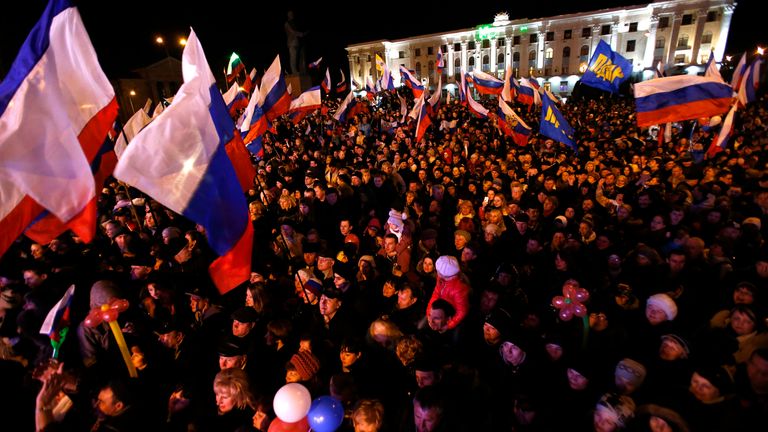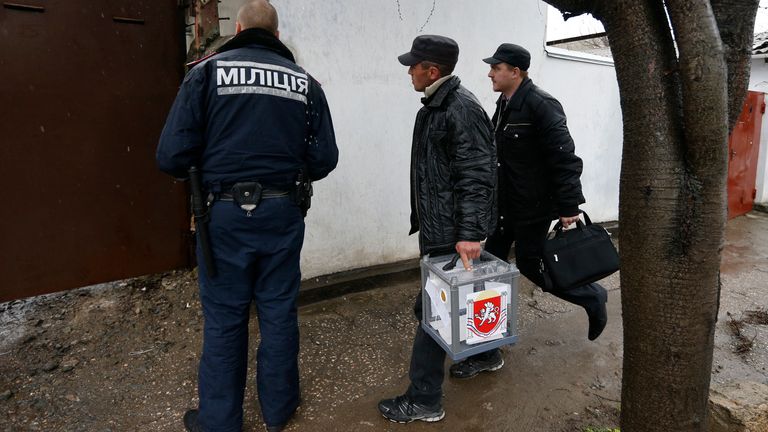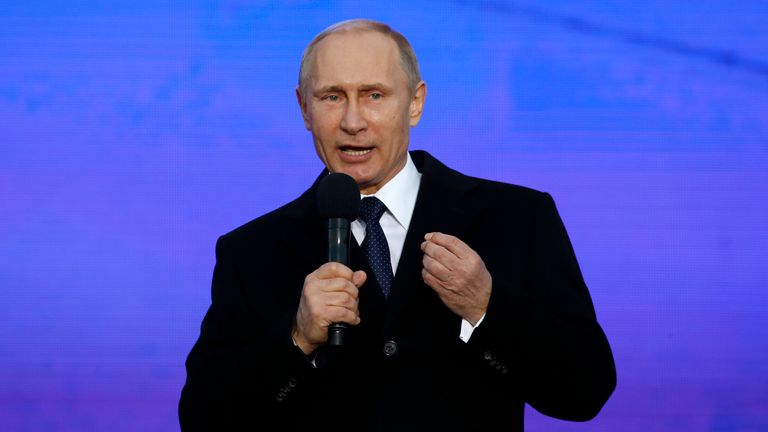Vladimir Putin gave his explicit support to the referendums which will be held in the coming days in the parts of Ukraine occupied by Russian forces.
They are to be held in the self-proclaimed people’s republics of Donetsk (DPR) and Luhansk (LPR), as well as in the Russian-occupied parts of the Kherson and Zaporizhzhia regions.
This could lead to the formal annexation by Russia of around 15% of Ukrainian territory, an area slightly larger than Portugal.
The move comes eight years after a similar process in Russian-occupied Crimea, which Moscow said justified the annexation of the peninsula.
Russian troops, many of whom are acting incognito, invaded Crimea before Moscow-aligned local leaders announced and then carried out a vote that many have called illegitimate and illegal.
There are fears that the latest announced referendums will be just as undemocratic.
Ukraine and Western countries condemned the referendum plans as an illegal sham and made it clear that they would never accept its results.
French President Emmanuel Macron said the vote plans were “a travesty”.
What is the precedent?
In February 2014, what were described at the time as mysterious little green men suddenly started appearing in the Ukrainian territory of Crimea, which to the eyes of the world looked like Russian troops, but without any insignia on their fatigues.
While Crimea had been transferred to Ukraine during Soviet times, it has an ethnically Russian majority, and some have welcomed invaders.
At the time, the Kremlin categorically denied that it was its troops or that it was annexing part of another European country.
Ukraine was stunned and unable to act quickly or effectively enough to challenge the invaders.
A few days after the soldiers appeared, a new government took power – effectively installed by the occupying forces – which then declared its independence from Ukraine and said it would hold a referendum on the future of the territory.
The vote was decisive, with 97% in the Autonomous Region of Crimea in favor of integrating the territory into the Russian Federation, with an 83% turnout, and in the local government of Sevastopol, 97% in favor of the integration to Russia, with an 89% of electoral participation.
A few days later, Vladimir Putin declared that Crimea was now part of Russia, despite widespread condemnation from the rest of the world.
The Ukrainian government, which had not been in power for long after the Maidan revolution, was furious but lacked the military strength to expel Russia from territory it was recognized as possessing under a series of international agreements.
The UN General Assembly passed a non-binding resolution declaring the Moscow-backed referendum in Crimea invalid, with 100 countries voting in favour, 11 against and 58 abstaining out of 193 nations, but little positive action was taken.
Many Western countries imposed sanctions, but Russia took them on the chin.
Events were quickly overtaken by separatists who rose up and demanded independence in parts of Luhansk and Donetsk, with the fighting that broke out there keeping the Ukrainian military busy for the rest of the decade.
If Russia has learned any lessons, it is that annexation could be achieved, if it acted in a way that meant that any challenge against it would be limited.
In the aftermath of the Crimean referendum, the Russian-backed separatist governments in Lugansk and Donetsk held their own polls on the right to autonomy, but amid heavy international criticism they did not offer the optional Russian integration.
Why a referendum?
While the referendum in Crimea was widely condemned, the result was decisive enough for Russia to claim that the people of the territory were in favor of joining the Federation.
Referendums have been widely used to determine the future of territories where part of the electorate demands independence, notably in Scotland in 2014.
The UN has supported referendums in many other countries that have demanded independence from others, such as South Sudan and East Timor, based on the fundamental principle of the right to self-determination.
But, unlike in Crimea, and likely in all four Russian-occupied regions, many of these previous referendums have been overseen by independent international observers, to ensure they are conducted as fairly as possible.
While support for integration with Russia appears to have been strong, the results of the Crimean referendum have been repeatedly called into question, as no international observers were present and the process proceeded so quickly.
Critics say turnout was far below the roughly 90% reported by Moscow-based authorities, and dissent is virtually non-existent due to the threat of what rights groups say is a crackdown .
What’s going to happen?
Several of the Russian-occupied regions had said they planned to hold referenda in the past, but had so far been unable to hold them.
This time, officials in Luhansk, Donetsk and Kherson said the referendums would take place between Friday September 23 and Monday September 27.
Russia does not fully control any of the four regions, with only around 60% of the Donetsk region in Russian hands, indicating that only those in Russian-controlled areas will be able to vote. In many areas that Moscow controls, people’s ability to vote is likely to be limited by wartime conditions.
If there is a majority in those four regions voting for Russian membership – presumably regardless of whether the vote is considered internationally legitimate – Mr Putin may well declare that they are now part of the Russian Federation.
What is the danger?
If Moscow officially annexes an additional part of Ukraine, Vladimir Putin is essentially challenging the United States and its European allies to risk a direct military confrontation with Russia, the world’s greatest nuclear power.
Mr. Putin uses his nuclear arsenal as leverage.
Russia’s nuclear doctrine authorizes the use of such weapons if Russia faces an existential threat from conventional weapons or if weapons of mass destruction are used against it.
Although there is no chance that the West will use nuclear weapons against Russia as a first strike, Ukraine is using conventional weapons to defend itself, firing into Russian-occupied territory to disrupt military lines. supply.
If these territories occupied by Russia are annexed and Mr. Putin declares that they are part of Russia, any attack on the annexed territories could be interpreted as an attack on Russia.
This would give Mr. Putin the potential pretext to use nuclear weapons in retaliation for Russia’s vast arsenal, which has more warheads than even the United States.
Dmitry Medvedev, who served as Russian President from 2008 to 2012 and is now Deputy Chairman of the Russian Security Council, said: “Encroachment on Russian territory is a crime that allows you to use all forces of self-defense”.



